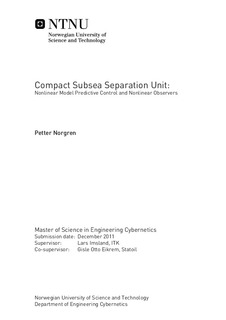Compact Subsea Separation Unit: - Nonlinear Model Predictive Control and Nonlinear Observers
Master thesis
Permanent lenke
http://hdl.handle.net/11250/2400590Utgivelsesdato
2011Metadata
Vis full innførselSamlinger
Sammendrag
In search of increased wealth and public prosperity, the oil industry have met new challenges in their quest for black gold. These challenges have driven Statoil's expertise to develop a compact subsea separation unit. The compact structure of this unit makes advanced process control a requirement. The study of this thesis will focus on conguring a NMPC with state process information supplied by a nonlinear observer. The study will be based on previous work on the Compact Separation unit. Statoil's internal MPC tool will be used for process control.
The state and parameter estimation performance of the implemented observers has been assessed with regards to both measurement noise and model/plant mismatches. This has been performed through simulations on the implemented model, but tests have also been conducted on an off-line data set from a test rig of the compact separation unit. The observers provided sufficiently accurate state estimates, with the exception being when the estimates were based on too severe measurement noise. The parameter estimation scheme proved to be suboptimal, but provided vital information during tests on the off-line data set.
The NMPC conguration developed during this project has been tested on several process disturbances, and have provided good results regarding regulation of the process within the desired control objectives. The conguration have proved to fulfill the performance criteria specied, both with the use of ideal process information and estimates supplied by the observers.
